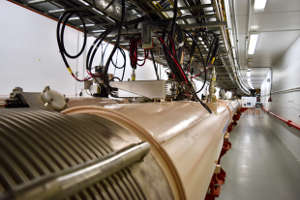Using AI to control energy for indoor agriculture
30 September 2024
Published online 27 January 2023
Surprising measurements of particle spin after heavy-ion collisions hint at previously unseen properties of the strong nuclear force.

Z22 CC-BY-SA-4.0
Now, collisions of gold nuclei performed by the STAR Collaboration at the Relativistic Heavy Ion Collider at Brookhaven National Laboratory, US, suggest that the strong force might exhibit unexpected fluctuations at short scales. The findings came from slightly off-centre collisions, which send the quark-gluon plasma swirling, affecting the spin property of the particles that emerge.
The STAR researchers focused on two such particles called Φ and K*0 mesons, which can each have three different spin orientations.
“Since the STAR detector couldn’t directly measure the spin direction, we measured the spin alignment of these particles by tracking the distribution of their decay products relative to the reaction plane of the colliding nuclei,” explains STAR spokesperson, Xu Sun, from the University of Illinois. “We then translate those measurements into a probability that the parent particle was in one of the three spin states.”
After many millions of collisions at a range of energy levels, the researchers could say with a high degree of certainty that K*0 mesons showed no preference for one spin state over another. However, the Φ mesons displayed consistent spin alignment – a preference for choosing one spin state.
“The observed spin alignment for the phi meson cannot be explained by conventional mechanisms, such as the magnetic field strength or the vorticity field generated in the particle collisions,” says Sun. Instead, theorists have proposed that local fluctuations in the strong force influence the Φ mesons to choose one spin state. Notably, Φ mesons are made up of a quark and antiquark of the same flavour family – ‘strange’ and ‘anti-strange’ – meaning the strong force effects act in the same direction and add up. K*0 mesons, on the other hand, are made from ‘down’ and ‘anti-strange’ quarks that experience the strong force in different directions, cancelling out the effects.
“This explanation is still subject to debate and further verification is needed,” says Sun. “Our plan is to measure a heavier meson called J/Ψ. Finding a global spin alignment preference for J/ Ψ would add support to the strong-force explanation.”
The STAR Collaboration is a truly global effort, comprising 721 collaborators from 71 institutions and 14 countries. A research group led by Ahmed Hamed, at the American University of Cairo, joined STAR in 2019 as the only independent member institute from the Middle East or Africa.
“Our undergraduate students Mohamed Samy and Fares Fawzy, and myself, took onsite shifts at the experiment, contributing to data collection, quality assurance and detector calibrations as well as joining in the scientific discussions on a weekly basis,” says Hamed. “We are intrigued to find out whether these newest observations are related to fluctuations in the strong field where there are many quarks and gluons around.”
doi:10.1038/nmiddleeast.2023.7
STAR collaboration. Pattern of global spin alignment of ϕ and K*0 mesons in heavy-ion collisions. Nature http://dx.doi.org/10.1038/s41586-022-05557-5 (2023).
Stay connected: